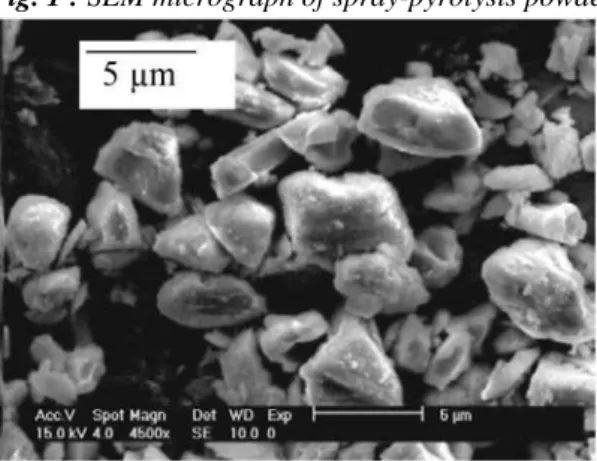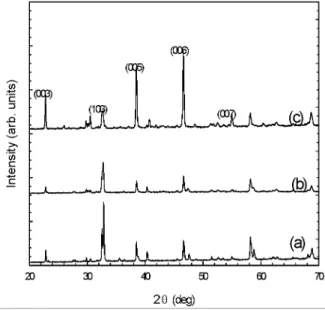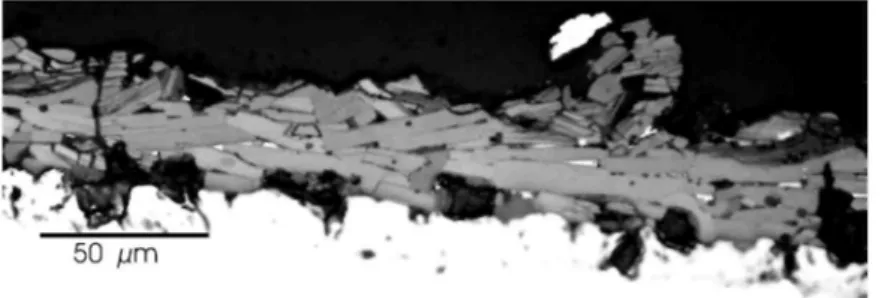Texturation of YBa
2Cu
3O
7-δThick Films by
Electrophoretic Deposition under Magnetic Field
L. Dusoulier1,2, S. Denis2,3, N. Nutal1, C. Henrist4, B. Vanderheyden3, Ph. Vanderbemden3, A. Rulmont1, M. Dirickx2, M. Ausloos4, R. Cloots1 and B. Vertruyen1.
1 SUPRATECS, Chemistry Institute B6, University of Liège, B-4000 Liège, Belgium
2 SUPRATECS, Communication, Information Systems and Sensors Department; Royal MilitaryAcademy, B-1000 Brussels, Belgium 3
SUPRATECS, Department of Electrical Engineering and Computer Science B28, University of Liège, B-4000 Liège, Belgium 4 SUPRATECS, Physics Institute B5, University of Liège, B-4000 Liège, Belgium
4 Centre for Applied Technology in Microscopy (CATµ), University of Liège, B-4000 Liège, Belgium
Abstract
YBa2Cu3O7-δ coatings were deposited by electrophoretic deposition (EPD) onto Ni substrates. Particles of different sizes and shapes were used in order to study the influence of the powder microstructure on the film density. Texturation of the thick films was induced by application of a magnetic field during the electrophoretic deposition. X-ray diffraction analysis has clearly shown preferred c-axis alignment of the YBa2Cu3O7-δ films along the direction normal to the substrate surface. Scanning electron microscopy and optical polarised light microscopy were used to characterise the microstructure of the coatings, revealing a non-random platelets organisation.
Keywords: Electrophoresis, magnetic texturation, coatings, YBa2Cu3O7-δ, superconductors
I. Introduction
Technical applications of superconductors require the development of simple methods to produce films with appropriate superconducting properties. In particular, the production of complex-shaped coatings is needed to use superconductors for realisation of efficient magnetic shields [1]. Electrophoretic deposition (EPD) meets these requirements. To produce films, the superconducting YBa2Cu3O7-δ (YBCO) particles have firstly to become charged (positively) in acetone medium. The next step is applying a voltage between two electrodes in the suspension. A migration of particles occurs and initiates the film growth onto the oppositely charged electrode [2,3].
In REBaCuO compounds (where RE is yttrium or a rare-earth cation), it is well established that the electrical current flows more easily in the a-b planes of the crystal than in the c-axis direction. Therefore the current density in the films deposited by EPD is likely to increase if preferential particles orientation can be achieved. Previous studies [4,5,6] have shown that texturation of polycrystalline YBaCuO samples by application of a magnetic field is possible due to magnetic anisotropy of the compound [7].
In this paper, the deposition of YBa2Cu3O7-δ (YBCO) particles was investigated in the presence and the absence of a magnetic field (µ0H = 1.5 T). In comparison with other authors [4,5,6], the magnetic field applied in this case may seem weak, but texturation of REBaCuO films can also be influenced by the shape of the particles, especially their aspect ratio. For example, Ondonõ-Castillo and Casañ-Pastor [8] have pointed out that two opposite forces act during migration of planar particles : the tendency of the electrical field to orient the shorter axis perpendicular to the substrate is counteracted by hydrodynamic effects. In the present paper two different powders were composed : (i) a commercial powder obtained by spray pyrolysis and (ii) a home-made powder prepared by oxalate coprecipitation method. Optimisation of the thermal treatment allows us to obtain particles with tabular aspect ratio (platelets) in the case of the oxalate method. The density and texturation of the coatings obtained from the different powders were studied by X-ray diffraction, scanning electron microscopy and optical polarised light microscopy, revealing a non-random platelets organisation.
II. Experimental
Two kinds of powders were used in the present study. A YBCO commercial powder synthesized by a spray-pyrolysis method was purchased from Alfa-Aesar (99 .9%, ref. 039534). Home-made YBCO powders were prepared by the oxalate coprecipitation method [9,10]. Adequate quantities of Y(NO3)3.6H2O, Ba(NO3)2 and Cu(NO3)2.3H2O were dissolved in water. Oxalic acid (10% in excess) was then added to the solution. The pH was adjusted to 7.5 with ammonia. The filtered precipitate was heated up to 900°C to obtain YBCO powder. An
additional sintering step was carried out in order to promote the grain growth. The influence of the sintering temperature was studied by comparing coatings sintered at 910°C, 930°C, 950°C, 970°C and 990°C during 12h (heating and cooling rates : 100°C/h).
Suspensions were prepared by mixing l0g/l of ceramic powder and 200mg/l of I2 in 100 ml of acetone, followed by sonication. Ni plates were used as cathode and Ni (when H=0) or Cu (when H≠0) plates were used as anode. Inter-electrode distance was kept between 0.5 and 1 cm. The magnetic field (µ0H = 1.5 T) was generated in the horizontal direction, either perpendicular or parallel to the electrode planes. Electrophoretic depositions were performed at 200 V during 3 minutes. As-deposited films were heated afterwards to 940°C during 12h (heating and cooling rates: 100°C/h).
X-ray diffraction patterns were measured with a Siemens D5000 diffractometer (Cu Kα radiation). Cross-sections of the coatings were characterised by optical polarised light microscopy (Olympus AH3-UMA) and powder by scanning electron microscopy (Philips FEG-XL30).
III. Results and discussion
The microstructure of the two kinds of powders after sonication in acetone was studied by scanning electron microscopy. Figure 1 presents a micrograph of the commercial powder (hereafter named "YSP powder"). That powder, synthesised by spray pyrolysis, is made up of grains of various shapes and sizes (typically between 2 and 6 µm). Figure 2 shows a micrograph of the powder obtained by oxalate coprecipitation followed by thermal treatment up to 950°C ("YOX powder"). The temperature of the thermal treatment was optimised in order to maximize the proportion of grains with tabular facets. Grain size of the YOX powder is between 10 and 30 µm.
Fig. 1 : SEM micrograph of spray-pyrolysis powder (YSP powder).
Fig. 2 : SEM micrograph of oxalate coprecipitation powder (YOX powder).
X-ray diffraction patterns of YBa2Cu3O7-δ coatings from YSP and YOX powders are shown in figures 3 and 4 respectively. Reference patterns of the starting powders are also presented for comparison. The degree of c-axis orientation can be evaluated from the (006)/(103) XRD peak ratio.
In both cases, there is no significant difference between the patterns of the powders and the coatings without any applied magnetic field (see fig. 3 and 4, patterns (a) and (b)). The platelet shape of most of the YOX particles
does not seem to lead to enhance preferential orientation when compared to the YSP smaller grains.
Magnetic field was applied in two different directions. When the electrodes were perpendicular to the magnetic field, no modification of the XRD patterns was observed (not shown here). On the contrary, the c-axis
orientation was always enhanced when electrodes were parallel to the magnetic field. Preferred orientation was more pronounced in the case of the YSP coating ((006)/(103) ratio ~ 13, see fig. 3c) than in the case of the YOX coating ((006)/(103) ratio ~ 8, see fig. 4c).
Fig. 3 : X-ray diffractograms of (a) YSP powder, (b) coating with YSP powder without magnetic field and (c)
coating with YSP powder with magnetic field parallel to the electrodes during deposition.
Fig. 4 : X-ray diffractograms of (a) YOX powder, (b) coating with YOX powder without magnetic field and (c)
coating with YOX powder with magnetic field parallel to the electrodes during deposition.
According to these X-ray patterns it is clear that magnetic texturation of YBCO coatings is effective.
Comparison of the YBCO coatings produced with powders of different grain sizes and shapes seems to indicate that smaller grains are more easily oriented by the application of a magnetic field. This fact was also
demonstrated in slip base on alumina platelets [11].
Strong c-axis texture is not the only requirement for good current density in superconducting coatings. Film density is also a major parameter. In order to investigate the influence of the size and shape of the particles on
the film density, cross-sections of the coatings were characterised by optical polarised light microscopy. By this technique, grains with different orientations appear coloured in different shades. Single layer coatings was not optimal for grains observation, therefore multilayer coatings were deposited for that purpose.
Figure 5 shows the optical micrograph of the coating produced with the YSP powder in magnetic field during deposition. The thickness of the coating is about 70 µm and the film is constituted of randomly stacked small grains with significant porosity. Figures 6, 7 and 8 present optical micrographs of coatings with the YOX powder without magnetic field (fig. 6), with magnetic field parallel to the electrodes (fig. 7), and with magnetic field perpendicular to the electrodes (fig. 8). Generaly, these films have thickness between 30 and 50 µm but some defaults are visible.
Fig. 5 : Optical polarised light micrograph of a YSP coating with magnetic field parallel to the electrodes
during deposition.
Fig. 6 : Optical polarised light micrograph of a YOX coating without magnetic field during deposition.
Fig. 7 : Optical polarised light micrograph of a YOX coating with magnetic field parallel to the electrodes
during deposition.
Fig. 8 : Optical polarised light micrograph of a YOX coating with magnetic field perpendicular to the elctrodes
In the YOX coating without magnetic field (fig. 6), platelets are oriented in random directions. Application of a magnetic field parallel to the electrodes appears to force the anisotropic grains to pile up parallel to the substrate (fig. 7), so that the particles are mainly oriented with their a-b planes parallel to the substrate. The opposite stacking feature occurs when the magnetic field is applied perpendicularly to the substrate (fig. 8): most of the platelets have their a-b planes grossly perpendicular to the electrode. These results confirm the data obtained by X-ray diffraction.
The density of the YOX film deposited have to be improved (fig. 7) for obtained higher superconducting current density. In the case of the films deposited under a magnetic field, very dense zones are separated by some cracks or pores. But especially in the case of the coating realised with the magnetic field parallel to the electrodes, the platelets are very regularly stacked one over each other. Optimisation of the size distribution of the powder, either by sieving or presedimentation, might reduce the tendency to cracking.
IV Conclusion
Texturation of YBa2Cu3O7-δ thick films on Ni was achieved by applying a magnetic field during the electrophoretic deposition. Comparison of the XRD patterns of YBCO coatings produced with powders of various grain sizes and shapes seems to indicate that smaller grains are more easily oriented by the application of a magnetic field. However, polarised light microscopy revealed that electrophoretic deposition of large tabular grains under magnetic field results in coatings with platelets well stacked one over each other. These very dense regions are separated by cracks. Optimisation of the size distribution of the particles will be undertaken.
Acknowledgements
BV is grateful to the Fonds National de la Recherche Scientifique (FNRS, Belgium) for a research grant. LD thanks FNRS for financial support.
References
[I] F. Pavese, Magnetic shielding, Handbook of applied superconductivity, B. Seeber, editor, IoP publishing (1998) 1461-1483 [2] P. Sarkar, P.S. Nicholson, J. Am. Ceram. Soc, 79, 8 (1996), 1987-2002
[3] I. Zhitomirsky, Adv. Coll. Inter. Sci., 97 (2002), 279-317
[4] M. Kawachi, N. Sato, K. Noto , M. Yoshizawa, Phys. C, 372-376 (2002), 802-805
[5] E. Meunier, F. Weiss, C. Villard, R. Tournier, J.W. Park, F. Hardinghaus, Inst. Phys. Conf. Ser. N° 167 (2000), 367-370 [6] M. Hein, E. Mahner, G. Müller, H. Piel, L. Ponto, M. Becks, U. Klein, M. Peiniger, Phys. C, 162-164 (1989), 111-112
[7] D.E. Farrell , B.S. Chandrasekhar, M.R. DeGuire, M.M. Fang, V.G. Kogan, J.R. Clem, D.K Finnemore, Phys. Rev. B, 36, 7 (1987), 4025-4027
[8] S. Ondonõ-Castillo, N. Casañ-Pastor, Phys. C, 268 (1996), 317-333
[9] M. Ochsenkühn-Petropoulou, R. Argyropoulou, P. Tarantilis, E. Kokkinos, K.M. Ochensenkuhn, G. Parissakis, J. Mat. Proc. Tech., 127 (2002), 122-128
[10] S. Vilminot, S. El Hadigui, His C.,Phys. C, 153-155 (1988), 387-388 [11] D. Brandon, D. Chen, H. Chan., Mater. Sci. Eng. A, 195 (1995), 189-196


